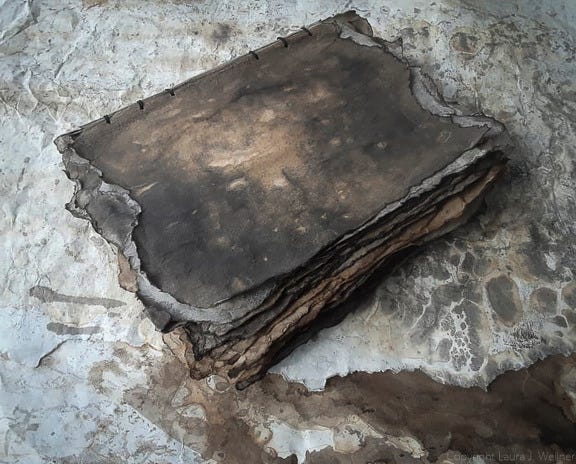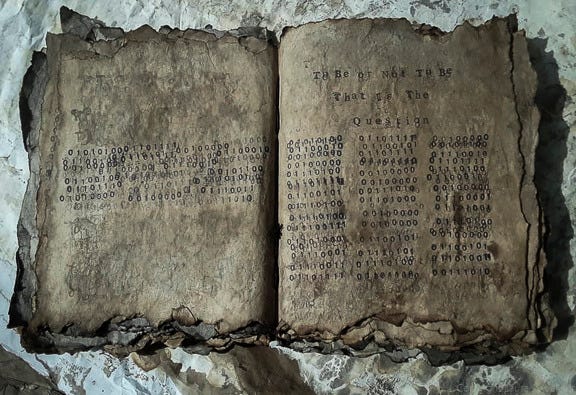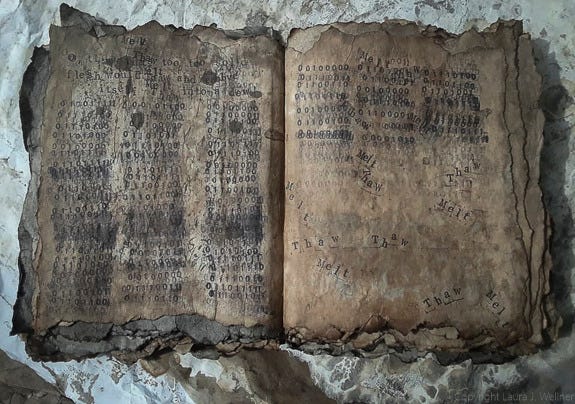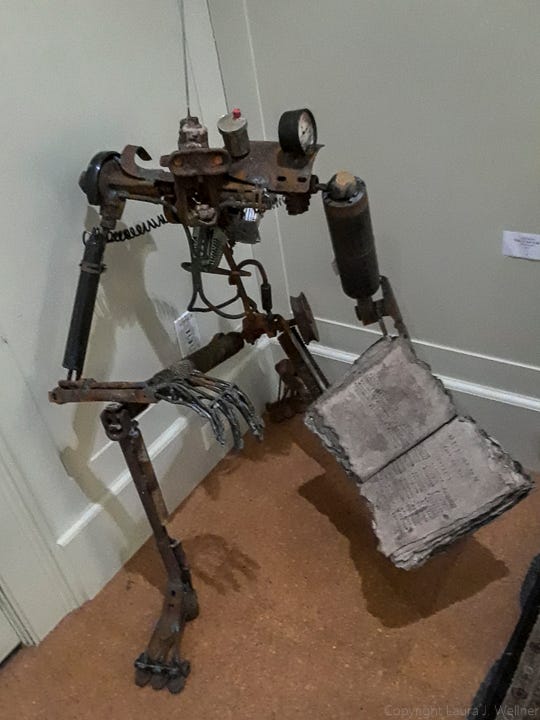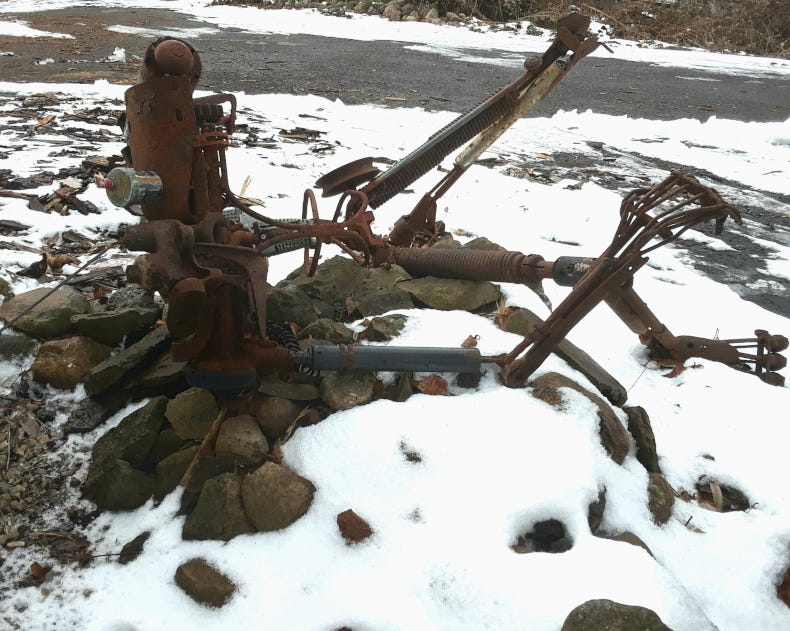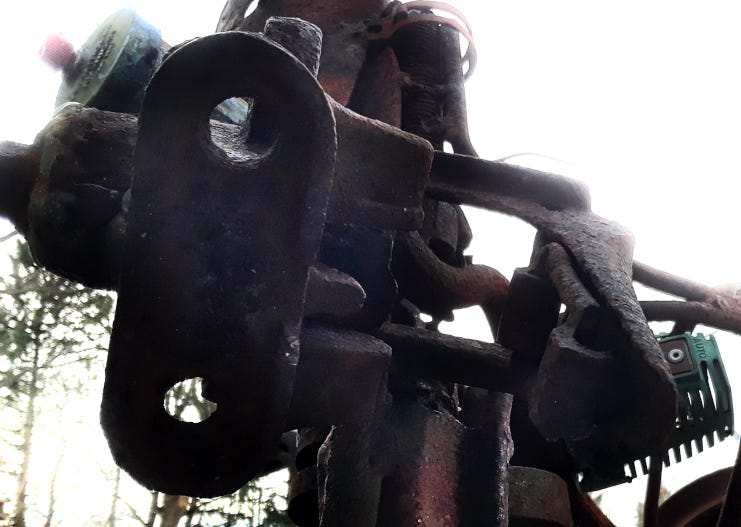To Be, or Not To Be
a handmade book with a rusty robot
Long story short—my Fred and I combined our talents to make a project, his robot, and my book. (Because, why not?)
He welded together this fellow from old parts, some dug up from our property or around our friend’s barn, most of them tractor parts, old valves from our boiler, and garage door springs, etc...my part is this handmade book. I worked on it for months, starting around November or December of 2018, staining papers while reading Shakespeare’s Hamlet. It was a fun project, not without frustrations, and it was exhausting at times.
I broke down Hamlet into fragments, mostly focusing on the To Be, or Not To Be soliloquy—one of the greatest and most quoted lines in literature. Death, the “undiscovered country” from which “no traveler has returned,” is a natural human preoccupation. I’ve treated the play much like Sappho’s poetry, a lost and found creation. It is the gathered remains of a culture no longer in existence. The irony of an aging robot finding this battered text and its AI contemplating the meaning of it is devastating.
The book is crudely bound in a Coptic-style binding. (I’ve never done it before, so it was a learning experience, and the imperfections were perfectly the way I wanted it.) It has the appearance of an ancient relic. Tattered and stained pages filled with fragments of printed and handwritten quotations, fragments of pages, some of which are translated to binary language of 1’s and 0’s. Some pages are hand-stamped letters and numbers, and most of them are off-register. Some of the pages are handwritten in scribbles, most of which are quotes that have been written and layered and then obliterated, blots of ink, tears, and holes.
We exhibited this project at the On My Own Time exhibition at Syracuse University in April-May 2019. The exhibition is for the University’s employees to showcase their “personal time” creative endeavors. It is a city-wide program, and other local businesses, schools, and institutions also participate in it. All the Best of Show artworks (selected by the judges) from each individual institution are exhibited at The Everson Museum of Art in downtown Syracuse.
It was always amazing to see what other people were doing with their talents outside of their day jobs. Working a full-time job and balancing time to make art (and write novels) with other obligations was a struggle for me. It was always a bittersweet thing for me to participate in this particular exhibition, I wouldn’t participate every year. There are a lot of people who are very creative and talented, and they may never be acknowledged outside of friends and family; it was a gesture for our employer to participate in the program that they didn’t have to do.
I loved that my Fred and I worked on this project together—it was our last time exhibiting before I retired in 2022 (and before COVID nixed everything for a couple of years.) Even though they are individual artworks that can stand on their own, having his robot holding my book was special.
However, sadly, Relic #2 has fallen on hard times as nature has taken its toll on it…which was part of the concept—as Relic was a rusty old thing to begin with...
My little book has its own archival box. I visit it often and think to myself that I should take another iconic book and do another one like it. I thought about Virginia Woolf’s The Waves, Bulgakov’s The Master and Margarita, or Melville’s Moby Dick. Or possibly doing Sappho with Greek and English translation, even more fragmented than it is.
I have too many ideas in my head—things I want to do—I don’t know if I will ever accomplish them all—but it is fun to think about them and imagine how I go about doing them. I do enjoy working in the book format.
To Be, or Not To Be is featured on my WordPress website laurajwellerart.wordpress.com. There is a full slideshow of the pages, and I hope you enjoy seeing them!
To Be, or Not To Be is a mixed media, handmade, hand-bound book (Coptic-style binding with waxed cord); cotton rag paper stained with India ink and walnut ink washes; handwriting done with crow quill pen and bamboo pen. Hand-stamped letters and Binary code numbers (1’s and 0’s) with archival stamp pad ink. Torn pages from a used copy of Shakespeare’s Hamlet adhered with archival adhesive. Inkjet-printed pages of Binary code are also adhered to pages with the same archival adhesive.
It is part of The Rare Book Library Project.
I want to thank you for visiting and reading—it’s awesome that you’re here. I want to especially thank my subscribers and welcome my new subscribers—I truly appreciate your support—it means a lot to me! Remember to be good to yourselves, okay?


